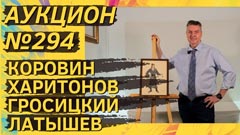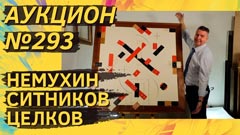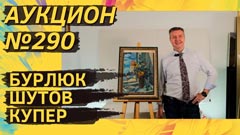
1970s UNOFFICIAL ART
SHULZHENKO Vasily Vladimirovich (1949) Two satyrs. 2017. Oil on canvas. 180 × 135
Artist Vasily Shulzhenko usually avoids questions about whom he paints the characters in his paintings from. He evades: “I paint from my head and any resemblances are coincidental”. But there is no cover here. The faces of merry satyrs are copied from our good friend Alexander Mironov (a collector) and Felix Bukh (Aron's son). The museum-scale canvas (human height) and rollicking painting with a Russian spirit is exactly the format that Shulzhenko's collectors especially appreciate. Others, however, hate him for this very reason, accusing him almost of Russophobia. Like an actor who plays a negative character, Shulzhenko is pestered for the heroes of his paintings — drunks and their rowdy girlfriends. Why? Where is the heroic image? However, for the artist, drunkards and marginals are not part of his surroundings, but an object of study. He watched these simple mores of the Russian provinces in his childhood, in the post-war years, when he lived in a dacha near Kasimov. But Shulzhenko himself is, on the contrary, quite a prosperous man. Back in Soviet times, he did not go astray. He was a member of the Union of Artists, a participant of national exhibitions. His age could have made him a representative of unofficial art, but he never had any connections with nonconformists. He reached his finest hour in creative solitude. It happens that way too.
1960s UNOFFICIAL ART
ROGINSKY Mikhail Alexandrovich (1931–2004) Bird market. 1977. Hardboard, oil. 25.5 × 63
Signature Roginsky of the valued 1977! Pre-immigration period, proper “urban” theme, melancholy painting. In other words, museum level.
Mikhail Roginsky is an artist of the second Russian avant-garde, a representative of “documentalism”, which today is considered to be the author's branch of “Russian pop art”.
The artist emigrated to France in 1978. Over the years, his painting became darker, more concise and critical. But the “Bird market” was painted a year before his departure — at the height of his creative powers. Boldly recommended for a solid collection.
YAKOVLEV Vladimir Igorevich (1934–1998) Abstract composition. 1975. Paper, gouache. 61 × 86
Abstract Yakovlev is a rare guest on the auction market. For many years we have seen only a few such striking experimental-geometric works. This particular gouache participated in the anniversary exhibition “Vladimir Yakovlev. And I want to stay on this bright...” It was held in 2014 at the State Literary Museum in honor of the 80th anniversary of the artist. The work was published in the catalog for this exhibition, which included articles by Valery Silaev and Nikolay Kotrelev. This catalog, by the way, we will present to the buyer. Provenance is impeccable, and, as expected, the information is recorded in the expert report of Valery Silaev.
Vladimir Yakovlev is an “artist of freedom”, a representative of the second Russian avant-garde, primitivist, a favorite of the Russian intelligentsia. Thousands of his drawings went to the homes of doctors, scientists, artists, poets and painters.
ZVEREV Anatoly Timofeevich (1931–1986) In the village house. Portrait of the collector Igor Anatolievich Kuznetsov. 1980. Canvas on cardboard, oil. 50 × 35
The name of the person sitting at the table with the bottle and glass is well known to art researchers and collectors. Igor Anatolievich Kuznetsov was a friend and executor of Anatoly Zverev. At him, in particular, Zverev kept savings book with the money from the sale of the house on the Nikolina Gora, which Oksana Aseeva bequeathed to the artist after her death. Kuznetsov kept the naval uniform in which Zverev served in the Navy. And of course, Kuznetsov kept Zverev's archive — a suitcase with treatises and poems by Anatoly Timofeevich, many drawings. Part of this heritage was transferred to the Tretyakov Gallery.
1980 is the year of the later Zverev, but experts admit that even in his late work there were flashes. And this is one of them. The portrait is definitely inspirational. You can see that Zverev worked with pleasure. And the piece turned out to be atmospheric, in time.
CHUBAROV Evgeny Iosifovich (1934–2012) Grief (All is nothing). 1967. Oil on canvas. 74 × 71
“The recluse from Mytishchi” Chubarov is one of the most powerful expressionists of unofficial art. After visiting his workshop-lair, Ilya Kabakov called Chubarov nothing short of a genius. And Chubarov himself seemed to shun recognition. He followed a path of intellectual seclusion. No exhibitions, no monographs, no catalogs. Only his bright talent kept him from oblivion.
To understand the scale of today's event, know that on average one or two paintings by Chubarov appear on the auction market per year. His paintings are a rarity. And then there's 1967! Early Chubarov in this work is more in tune with the artists of the “severe style”. Both in the manner of painting and in the gravity of the theme. However, “light” Chubarov does not exist in nature. Even his late ornamental abstractions did not exude frivolity. And here is a stark genre scene.
CHEMIAKINE Mikhail Mikhailovich (1943) St. George. 1962. Oil on canvas. 30 × 24.5
Before us is naive expressionism, neo-primitivist painting. And for a novice collector, it is not easy to recognize the handwriting of the artistic Mikhail Chemiakine in it. But connoisseurs remember that at the beginning of the way, the founder of “metaphysical synthetism” was exactly like that.
In the 1960s, the future pride of Russian art had a hard time in the USSR. In 1961, Chemiakine was expelled from the Repin Institute for “aesthetic corruption of fellow students”. The artist earned a living as a loader. Attempts to exhibit were suppressed. Thus, in 1964, the exhibition of artists-workers of the household section of the Hermitage, in which the loader-Chemiakine participated with Vladimir Ovchinnikov, was closed the very next day. And the director of the Hermitage was fired. In 1971, the artist was forced to emigrate and deprived of Soviet citizenship. In anticipation of a quick oblivion. But everything turned out differently. Twenty years later, Chemiakine returned to Russia already in the status of a star of international importance.
- Log in to post comments










